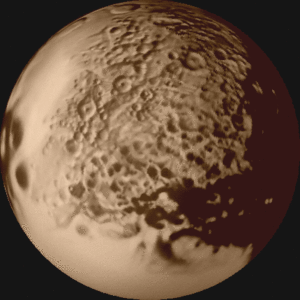Iapetus, Saturn's icy moon, is now 20 miles wider at the equator than the poles. An Iapetus day is nearly 80 Earth days long. The moon also has a broad bulge around its equator capped by a narrow ridge, giving it the appearance of a walnut.
Since long time, scientists were working to find out how it acquired its distinctive walnut shape since the ridge was discovered in 2004 in images from the Cassini spacecraft.
According to one theory, the moon was warmer and more malleable in its early days. If it also spun more quickly back then than it does now, it would have bulged out at its equator as a result. But if the moon's rotation later slowed, it would have become more spherical in shape.

|
| ©n/a |
| Iapetus |
National Geographic News quotes Dennis Matson, a scientist with NASA's Saturn-orbiting Cassini mission, as saying, "You would expect a very fast-spinning moon to have this bulge, but not a slow-spinning moon."
However, by that time, Iapetus turned colder and stiffer thus making it too rigid to mould itself into a smooth shape. The process left behind a distinctive ridge of material at the equator.
The new revelation was unveiled in a paper published in the online version of the journal Icarus.



including the Death Star dish weapon from the Star Wars series.
[Link]
;-)